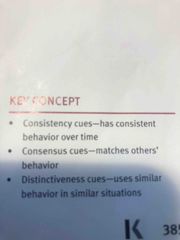![]()
![]()
![]()
Use LEFT and RIGHT arrow keys to navigate between flashcards;
Use UP and DOWN arrow keys to flip the card;
H to show hint;
A reads text to speech;
23 Cards in this Set
- Front
- Back
|
This explains how we form impressions about the chracteristics of individuals and groups of people. |
Social Perception |
|
|
Components of Social Perception |
Perceiver Target Situation |
|
|
The perceiver of social Perception if influenced by: |
Past experiences Motives Emotional State |
|
|
Difference of primacy effect and recency effect of social perception |
Idea that first impressions are important; idea that most recent information is important in forming our impressions |
|
|
Individuals tend to organize the perception of others based on traits and personal characteristics of the target that are most relevant to the perceiver. |
Reliance on central traits |
|
|
This theory states that there are sets of assumptions people make about how different types of people, their traits, and their behavior are related. |
Implicit personality theory |
|
|
Making assumptions about people based on the category in which they are placed |
Stereotyping |
|
|
Can explain why people perceived attractive people to be trustworthy and friendly |
Halo effect |
|
|
It is a cognitive bias in which judgments about specific aspect of an individual can be affected by one’s overall impression of the individual. |
Halo Effect |
|
|
It denies the possibility of good victims because good things only happens to good people and bad things only happens to bad people. |
Just-World Hypothesis |
|
|
It focuses on the need to maintain self-worth and can be done through internal attribution of succes and external attribution of failure. |
Self-enhancement |
|
|
Individual attributes success to internal locua of control while failures to external locus of control |
Self-Serving bias |
|
|
Which group will likely do a self-serving bias: close relationship, strangers, individuals who have high self-esteem? |
All except the close relationship |
|
|
It focuses on the tendency for individuals to infer the causes of other people’s bahavior. |
Attribution Theory |
|
|
These attributions are related to the characteristics of the individual as the primary cause. |
Dispositional Attributions |
|
|
This attribution is the same as the external locus of control. |
Situational Attribution |
|
|
This is likely to form when a person deviated from socially expected behavior. |
Dispositional attribution |
|
|
If a person behaves very different in every situations then |
Situational Attribution is formed |
|
|
What are the different cues and what would we expect to be done by the individual? |

|
|
|
Tells that we assume dispositional attributions more than the situational attributions. |
Fundamental Attribution Error |
|
|
It results from the self-serving bias ( by the actor ) and the fundamental attribution error ( by the observer ). |
Actor-observer asymmetry |
|
|
It occurs when individuals must make judgments that are complex, but instead they substitue a simple solution or apply a heuristic. |
Attribute Substitution |
|
|
T or F.Individualists are more likely to attribute behavior to dispositional factors wheras collectivist are more likely to attribute behavior to situational factors. |
T |

